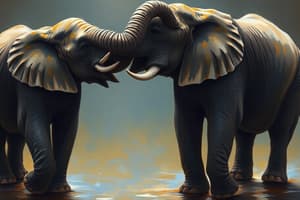Podcast
Questions and Answers
What type of behavior is characterized by innate actions that do not require learning?
What type of behavior is characterized by innate actions that do not require learning?
- Social Behavior
- Communication
- Learned Behavior
- Instinctive Behavior (correct)
Which of the following best describes altruism in animal behavior?
Which of the following best describes altruism in animal behavior?
- Competition for mating opportunities
- Group hunting strategies
- Selfless actions that benefit other individuals (correct)
- Aggressive behavior to secure territory
What is a primary example of learned behavior?
What is a primary example of learned behavior?
- Hibernation of bears
- Migration patterns of birds
- Mating rituals in frogs
- Problem-solving abilities in primates (correct)
Which mating system is characterized by a bond between one male and one female?
Which mating system is characterized by a bond between one male and one female?
What behavior refers to animals defending their territory?
What behavior refers to animals defending their territory?
Which communication method involves physical postures and movements?
Which communication method involves physical postures and movements?
How do circadian rhythms influence animal behavior?
How do circadian rhythms influence animal behavior?
Which behavioral adaptation allows animals to survive seasonal changes?
Which behavioral adaptation allows animals to survive seasonal changes?
Flashcards are hidden until you start studying
Study Notes
Animal Behavior
-
Definition: The way animals interact with each other and their environment, influenced by genetics and learning.
-
Types of Behavior:
- Instinctive Behavior: Inborn behaviors that do not require learning (e.g., migration, mating rituals).
- Learned Behavior: Behaviors acquired through experience and interaction (e.g., problem-solving, social learning).
-
Social Behavior:
- Territoriality: Animals defend specific areas to secure resources such as food and mates.
- Pack Behavior: Group dynamics in species like wolves and lions, affecting hunting and social structure.
- Altruism: Selfless behavior to benefit others, often seen in social insects and primates.
-
Communication:
- Vocalizations: Sounds used for mating calls, alerts, and group cohesion (e.g., birdsong, wolf howls).
- Body Language: Visual cues to express emotions or intentions (e.g., tail position in dogs, body posture in cats).
- Chemical Signals: Pheromones used for marking territory and attracting mates (common in insects and mammals).
-
Foraging Behavior:
- Hunting Strategies: Techniques used to catch prey (e.g., ambush, stalking, cooperative hunting).
- Food Selection: Preferences for certain food types based on nutritional value and availability.
-
Reproductive Behavior:
- Mating Systems:
- Monogamy: Pair bonding with one mate (e.g., swans).
- Polygamy: Having multiple mates (e.g., alpha males in some primate groups).
- Courtship Displays: Rituals to attract mates, including elaborate dances or displays (e.g., peacock feathers).
- Mating Systems:
-
Parental Care:
- Nurturing: Varies by species; some provide extensive care (e.g., elephants), while others leave offspring early (e.g., turtles).
- Learning from Parents: Young animals often learn survival skills from their parents or other adults through observation.
-
Circadian Rhythms:
- Daily Behavior Patterns: Activities such as feeding and sleeping that follow a 24-hour cycle, influenced by light and dark cycles.
-
Adaptations:
- Behavioral Adaptations: Changes in behavior to survive in specific environments (e.g., hibernation in bears, migration in birds).
-
Role of Environment:
- Habitat Influence: The physical environment shapes behavior and lifestyle, such as aquatic vs. terrestrial behaviors.
- Climate Effects: Seasonal changes can impact food availability and mating seasons.
-
Human Impact:
- Habitat Loss: Changes in natural habitats can alter animal behaviors and disrupt social structures.
- Climate Change: Affects migration patterns, breeding cycles, and food sources.
Definition of Animal Behavior
- Interaction between animals and their environment affected by genetics and learning.
Types of Behavior
- Instinctive Behavior: Innate actions such as migration and mating rituals that do not require experience.
- Learned Behavior: Acquired behaviors from experience, including problem-solving and social learning.
Social Behavior
- Territoriality: Defense of specific areas for resources like food and mates.
- Pack Behavior: Group interaction dynamics in species such as wolves and lions, influencing hunting and social organization.
- Altruism: Unselfish behaviors that benefit others, typical in social insects and some primates.
Communication
- Vocalizations: Sounds for mating calls, alerts, and maintaining group cohesion, such as birdsong and wolf howls.
- Body Language: Visual expressions of emotions or intentions, e.g., tail position in dogs and body posture in cats.
- Chemical Signals: Use of pheromones for territory marking and mate attraction, prevalent among insects and mammals.
Foraging Behavior
- Hunting Strategies: Diverse techniques for catching prey like ambush, stalking, and cooperative efforts.
- Food Selection: Preferences based on nutritional value and availability of specific food types.
Reproductive Behavior
- Mating Systems:
- Monogamy: Long-term pair bonding with a single mate, seen in species like swans.
- Polygamy: Multiple mating partners, common among alpha males in certain primate groups.
- Courtship Displays: Ritualistic behaviors aimed at attracting mates, notable examples include peacock feather displays.
- Parental Care:
- Nurturing Methods: Range from extensive care in species like elephants to minimal care in species like turtles.
- Learning from Parents: Young animals acquire survival skills through observing adult behaviors.
Circadian Rhythms
- Daily Behavior Patterns: Feeding and sleeping activities follow a 24-hour cycle influenced by light and dark changes.
Adaptations
- Behavioral Adaptations: Modifications in behavior for survival in unique environments, such as hibernation in bears and migratory patterns in birds.
Role of Environment
- Habitat Influence: The environment shapes behaviors and lifestyles, differentiating aquatic from terrestrial actions.
- Climate Effects: Seasonal variations impact food availability and mating behaviors.
Human Impact
- Habitat Loss: Alterations in natural habitats can disrupt animal behavior and social structures.
- Climate Change: Influences migration patterns, breeding cycles, and food supply availability.
Studying That Suits You
Use AI to generate personalized quizzes and flashcards to suit your learning preferences.





